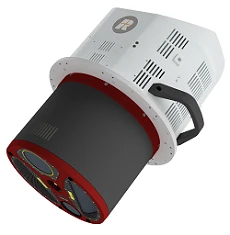RIEGL VQ-1560III-S Dual Channel Airborne Laser Scanning System
Description
The VQ-1560 III-S is the latest successor in the proven RIEGL dual channel laser scanning system series, suitable for a wide field of applications in airborne mapping.
The well-established “cross-fire” scan pattern enables a forward and backward view to the edges of the swath and a nadir view in the middle of the swath resulting in best point distribution for optimum target sampling. High pulse repetition rates of up to 4.4 MHz allow for operational flying altitudes of up to 1,600 m AGL, or up to 3,900 m AGL at a pulse repetition rate of 560 kHz (all values given for 20% target reflectance).
A high-performance IMU/GNSS unit and one or two optional high resolution RGB/NIR cameras are seamlessly integrated in the compact and user-friendly designed housing.
The excellent scan pattern and its wide operational range make the instrument one of the most versatile airborne laser scanners on the market today. It is perfectly suited for any kind of application; from ultra-dense corridor mapping from low altitudes, over high-resolution city mapping with minimum shadowing effects in narrow street canyons, to large-scale wide area mapping at utmost efficiency of up to 1,130 km² per hour at a density of 4 points per square meter.
RIEGL VQ-1560III-S Dual Channel Airborne Laser Scanning System
Specifications |
|
|---|---|
| Maximum Measurement Range: | 1600 m |
| Minimum Measurement Range: | 100 m |
| Measurement Rate: | 2930000 meas./sec |
| Accuracy: | 20 mm |
| Precision: | 20 mm |
| Laser Pulse Repetition Rate: | Up to 4.4 MHz |
| Data Storage: | Removable hard disks |
| IMU/GNSS Integration: | High-performance integrated unit |
| Camera Options: | RGB/NIR cameras (optional) |
| Operational Range: | Wide altitudes and densities |
| Mapping Efficiency: | Up to 1,130 km²/hour at 4 points/m² |
| Point Density: | Ultra high-resolution capability |
| Environmental Use: | Optimized for various terrain and weather conditions |
| Field Of View: | 100° |
| Laser Class: | Class 1 (eye-safe operation) |
| Weight: | 2.65 kg |
| Dimensions: | 225x180x125 mm |
| Power Supply: | 28 V DC, 65 W |
| Operating Temperature: | -20 to +50 °C |
| Software: | RiACQUIRE, RIEGL’s proprietary suite |
| Ntegration Options: | Compatible with UAVs, manned aircraft |
Features
- high pulse repetition rates of up to 4.4 MHz
- up to 2.93 million measurements per second on the ground
- best point distribution for optimum target sampling
- atmospheric clutter suppression
- multiple target capability
- online waveform processing and full waveform data recording
- increased sample block lengths
- on-board graphical user interface for easy access to primary scanner parameters
- integrated inertial measurement unit and GNSS receiver
- prepared for the integration of up to two high resolution RGB/NIR cameras
- optimized for interfacing with typical hatches and stabilized platforms
- detachable handgrips for facilitated handling
Applications
- Ultra Wide Area / High Altitude Mapping
- Ultra-High Point Density Mapping
- Mapping of Complex Urban Environments
- Glacier & Snowfield Mapping
- Mapping of Lakesides & River Banks
- Agriculture & Forestry
- Corridor Mapping
For pricing, technical or any other questions please contact the supplier
- No registration required
- No markups, no fees
- Direct contact with supplier
-
Ships from:
Austria
-
Sold by:
-
On FindLight:
since 2019
Frequently Asked Questions
The RIEGL VQ-1560III-S supports operational flying altitudes of up to 1,600 m AGL at 20% target reflectance, and up to 3,900 m AGL at a pulse repetition rate of 560 kHz.
The "crossfire" scan pattern enables a forward and backward view to the edges of the swath and a nadir view in the middle. This ensures optimal coverage and high-quality data collection across the entire scanning area.
The pulse repetition rate can be fine-tuned in 12 kHz steps, allowing for precise optimization of the acquisition parameters to meet the specific needs of a given project.
The VQ-1560III-S is suitable for a variety of applications, including ultra-wide area mapping, high-density city mapping, corridor mapping, glacier and snowfield mapping, agriculture, forestry, and urban modeling.
Yes, the system can be equipped with one or two optional high-resolution RGB/NIR cameras to provide additional imaging capabilities and enhance data accuracy.
Data is stored on removable hard disks that can be accessed directly on the device, eliminating the need for an external data recorder and simplifying the data transfer process.
Yes, the system is designed with a standardized mounting flange that fits typical hatches and gyro-stabilized leveling mounts, ensuring optimal point distribution during flight.
The VQ-1560III-S can map up to 1,130 km² per hour at a point density of 4 points per square meter, making it highly efficient for large-scale surveys.
The VQ-1560III-S adjusts its performance based on target reflectance, with the ability to optimize pulse repetition rates for different reflectance levels, ensuring accurate data collection in diverse conditions.
The system supports both online and full-waveform processing for advanced target detection, providing high accuracy and versatility in data acquisition and processing.

